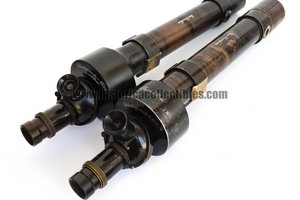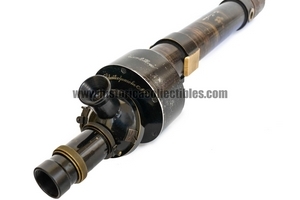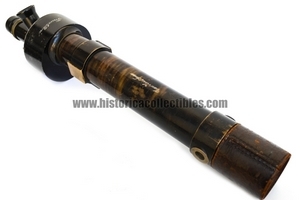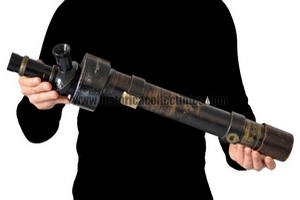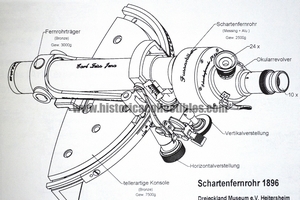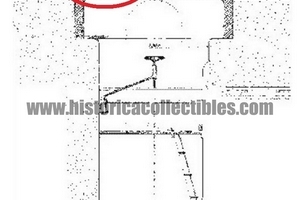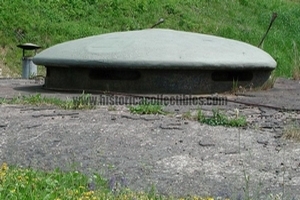Schartenfernrohr 96 Modell 1° (Fortress Telescope), Zeiss 10-24x45, Fussartillerie, 1896
Fortress Telescope, Model 96, with Revolver 10x and 24x and objective lens of 45 mm, produced by Carl Zeiss Jena in 1896, to be installed in the towers of the observers of Fussartillerie, in defense of the Fortress of Kaiser Wilhelm II.
At various points of the telescope provides the following information:
- On the revolver plate "Schartenfernrohr N°7" or Loophole Telescope N°7;
- On the barrel prisms "Fussartillerie" or Foot Artillery;
- On the tube the mark of the producer "Carl Zeiss, Jena.";
- Above the objective lens "V.O. z. S. F. N°7" respectively Vorrats zum Objektiv Schartenfernrohr Fussartillerie N°7 " Objective parts for Loophole Telescope of Fussartillerie.
The revolver is equipped with a special lever locking system.
The 24x eyepiece has a crosshair reticle instead the 10x eyepiece has a grid of 4 lines and you can adjust its position using the knurled nut.
The view is clear and collimated and all mechanisms are working properly. Excellent storage conditions.
This Schartenfernrohr is the oldest known to date.
Carl Zeiss takes its name from its founder, Carl Zeiss, who on November 17, 1846 chose the small town of Jena, in Thuringia, as the location for his precision optical equipment factory. Thanks to the severe quality control that Carl Zeiss imposed on his products, going so far as to personally destroy the microscopes that did not pass the tests, the newly formed Zeiss became the official supplier of the University of Jena and received the gold medal of the industrial exhibition in 1861 of Thuringia as the best research instrument produced in Germany, awarded to the Stand I microscope of 1857.
In 1866 the thousandth microscope was produced and the name Zeiss became known throughout European scientific circles. Thanks to studies on the Porro prism, in 1893 Abbe patented double prism binoculars, which accentuated the perception of depth. The mass production of Zeiss binoculars began in 1894, already at the beginning of the twentieth century more than 30,000 were made, at the beginning of the First World War the quota had risen to 500,000 and, at the end of the Second World War, as many as 2,260,000 were produced binoculars for the civil and military market.
Models were made starting from 4x11 mm to 12x40 mm, up to real giants such as the 80 mm and 100 mm.
Thanks to studies conducted on the perception of light in low light situations, it was demonstrated that the average dilation of the pupil in an adult is approximately 7 mm.
For this reason, the 7x50 mm model was introduced in 1910 and remained on the market until 1917 with few changes to the materials used. In 1926, following the post-war crisis of the First World War with the Treaty of Versailles which bankrupted many important German companies, Zeiss purchased "C.P. GOERZ" and founded Zeiss Ikon in 1926.
In 1937 Zeiss had commercial contacts and factories in more than 29 countries around the world. From '33 Zeiss acquired interest from the Nazi regime, which balanced production towards military instruments. It successfully produced binoculars with wide-angle optics for military use, pressure-resistant optical systems for U-boats, periscope binoculars for targeting tanks. Furthermore, Zeiss cameras were mounted on the V2s for remote sensing operations of the English coasts.
On 1 November 1935, Zeiss, in the figure of Alexander Smakula, patented a process for the treatment of optical glass with extraordinary results in terms of light transmission. Remained a military secret until 1939, it was adopted on binoculars to reduce ghost images and internal reflections. During the Second World War, there were numerous bombings against the Zeiss factories. Jena was bombed several times by the Allies starting in 1944. Stuttgart was razed to the ground, although the Contessa-Nettel factory suffered little damage. The bombing of Dresden, in addition to devastating the city, also caused considerable damage to the Zeiss Ikon headquarters.
On April 13, 1945, American military forces entered Jena, surprising themselves that the bombing had not caused any significant damage. The main planetarium was in ruins, while the factories remained operational.

